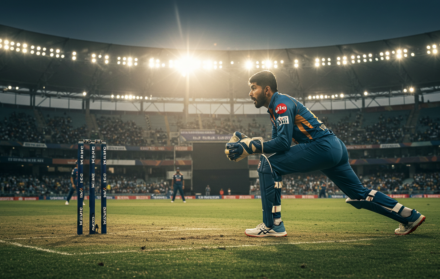
Travis Head: Big Game Player or Flat-Track Bully?
Few players in modern cricket inspire such sharply split opinions as Travis Head. To some, he’s Australia’s answer to the evolving demands of white-ball cricket—a free-flowing left-hander capable of dismantling attacks from the get-go. To others, he’s a beneficiary of good conditions, a player who flatters to deceive when the surface offers a challenge or the match stakes turn suffocating.
This polarisation isn’t new. Head’s career has long been a sequence of bursts and lulls—electric centuries followed by lean stretches that spark questions about temperament, technique, and adaptability. Yet, he’s also stepped up on days when it mattered most. His performances in the 2023 World Test Championship Final and the ODI World Cup Final against India were not just match-winning—they were defining.
So which is it? Is Head the embodiment of Australia’s new aggressive identity, or a player whose success is conditional on pitch and pressure? This article aims to explore the duality at the heart of Head’s career, dissecting his record, temperament, and technique across formats and conditions. We’ll look at where he thrives, where he falters, and whether the “big game player” tag is one he’s truly earned—or just occasionally borrowed.
1. From Fringes to Finals: Head’s Evolution in the Australian Setup

When Travis Head burst onto the scene, he was seen as a flair-driven prospect—someone with the stroke range and intent to light up the middle order. But inconsistency shadowed his early international career. After his debut in 2016, he bounced in and out of squads, particularly in Tests, often finding himself labelled as promising but unreliable.
By 2021, Head was at a crossroads. With competition from more technically compact players, many expected his ODI place to slip. Yet he responded by reworking his game—not in style, but in decision-making. His shot selection matured, his ability to pick gaps improved, and critically, he began converting starts into scores that changed matches.
In the 2023 World Test Championship Final against India at The Oval, Head exploded with a 163 off 174 balls, nullifying India’s seam attack with counter-punching brilliance. It was a knock that redefined his narrative. No longer just a dasher, he became the man who controlled the game’s tempo when the stakes were at their highest.
Months later, in the ODI World Cup Final in Ahmedabad, he stunned a packed home crowd with a match-winning 137 off 120 balls, silencing critics who had claimed he could only score on easy tracks. His innings combined flair with patience—starting cautiously and then dismantling India’s spinners in the middle overs with measured brutality.
These performances suggest something significant: Head doesn’t just score when things are easy. He scores when Australia needs it most. But are these outliers or a pattern forming?
2. Home Comforts: A Dominator on Familiar Turf
One reason the “flat-track bully” label has followed Travis Head is his commanding record on Australian soil. At home, his numbers are exceptional. In ODIs, he averages over 50 with a strike rate comfortably above 100. His Test record also sparkles—averaging over 50 in home conditions with multiple centuries against top-tier sides.
These performances aren’t just statistical anomalies. They reveal a batter who is completely at ease with the pace and bounce of Australian wickets, especially at venues like Adelaide Oval and the Gabba. He plays the short ball early and with authority, often taking the attack to bowlers in the first 20 minutes of his innings—an uncommon trait in a format known for caution.
His century against England in the 2021 Ashes Test at the Gabba, scored off just 85 balls, became a template for his intent-driven approach. That knock was ferocious but also precise, featuring crisp drives, upper cuts, and firm pulls that exploited every loose delivery.
But it’s this very fluency at home that leads to questions about his performances elsewhere. Detractors argue that his dominant record in familiar surroundings masks his inconsistencies overseas, especially in subcontinental and swinging conditions. Against spin, particularly on slower tracks in Asia, Head has occasionally looked tentative—prone to sweeping across the line or charging without conviction.
Still, it’s important to distinguish comfort from limitation. Most players have better home records. What matters more is how Head has evolved his game when taken out of that comfort zone. And to judge him fairly, we must place his away performances under the microscope—not just for failures, but for signs of growth.
3. The Away Game: Struggles, Adaptations, and a Turning Tide?

Criticism of Travis Head’s overseas record isn’t without merit. Early tours to the subcontinent saw him vulnerable against spin and reverse swing. In India and Sri Lanka, he averaged below 30 in Tests, often dismissed while trying to force pace on slow tracks—an approach that backfired under pressure.
During the 2018 Test series in the UAE against Pakistan, Head showed glimpses of resolve with a gritty 72 in Abu Dhabi. But technical cracks appeared. His tendency to play with hard hands and his impatience against spin allowed bowlers to set simple traps. For a while, it looked like Head might go the way of many attacking batters: dominant at home, expendable abroad.
Yet, Head didn’t retreat—he adapted. By the 2022–23 tour of India, while he wasn’t prolific, there was visible change. He played later, swept more judiciously, and resisted the urge to manufacture boundaries early in his innings. In the Nagpur Test, despite failing in the first innings, he adjusted and made a quickfire 43 in the second—a knock that, while brief, hinted at a recalibration of mindset.
In ODIs, too, signs of adaptation emerged. During Australia’s 2022 tour of Pakistan, Head opened the innings and scored a fluent 101 off 72 balls in Lahore. The innings featured a more measured start, where he allowed himself time before launching into the spinners—showing that when he curbs the impulse to dominate from ball one, he becomes more dangerous, not less.
Head’s away record is still a work in progress. But what stands out now is not just the improvement in numbers—it’s the change in approach. If that continues, the perception of him as a flat-track bully may eventually give way to something far more complete: a batter learning to translate intent into maturity, even under foreign skies.
4. Finals, Pressure, and the Fire Within
What separates a decent international cricketer from a big game player is not just numbers—it’s timing. The ability to perform when the stakes are highest, when the margin for error is thinnest, is a quality that few possess. In this context, Travis Head is building a compelling case.
The 2023 World Test Championship Final at The Oval was one of the most high-pressure matches in the calendar. Australia, coming off a long tour, faced an India side packed with batting depth and world-class bowlers. Early wickets had fallen. The ball was seaming. And then came Head—counterattacking from ball one, disrupting line and length, and eventually producing a breathtaking 163 off 174 balls.
This wasn’t just a good innings. It was a tone-setter. It wrestled control away from India and put Australia in a dominant position they never relinquished. Head’s strike rate of 93 in a Test final, on English soil, under pressure—against Shami, Siraj, and Jadeja—was a reminder that some players don’t just survive the big stage; they reshape it.
Fast forward five months to Ahmedabad. Over 100,000 Indian fans packed the stadium for the 2023 ODI World Cup Final. India were unbeaten. The pitch was slow. Early wickets tumbled. Australia were under the pump. And Head, returning from injury, delivered one of the great final innings: 137 off 120 balls, mixing aggression with maturity. He paced his innings beautifully—waiting out the tough phase, then exploding once he got in.
These performances weren’t coincidences. They were evidence of temperament—of a player who may not be consistent in every series but knows how to rise when it matters most. And for all the murmurs about flat tracks, these knocks came in world finals, against elite bowling attacks, in hostile conditions.
5. Mentality Over Mechanics: What Drives Head’s Game

For years, analysts focused on Travis Head’s technique—his fast hands, upright stance, occasional hard hands through the off-side. But as his career has progressed, it’s become clear that his greatest asset may not be mechanical at all. It’s mental.
Head is not a batter who overthinks. He backs his instincts. That can be a double-edged sword—leading to reckless dismissals or golden spells of dominance. But when he finds the balance, his intent becomes his superpower. He doesn’t play innings of survival—he plays innings of direction.
One of Head’s understated qualities is how quickly he gets into his innings. His average balls faced before reaching double digits is among the lowest in world cricket, and his strike rate in the first 20 balls often crosses 100. That kind of intent puts immediate pressure on bowlers and forces captains to alter field plans prematurely.
But there’s a subtler layer, too. In recent years, Head has started talking more about match situations. During the 2023 World Cup, he spoke about watching India bowl and planning how to absorb the early overs. In the Test Championship Final, he said he felt no pressure because the scoreboard pressure was “low enough to play his game.” These aren’t throwaway lines—they show a growing understanding of tempo, situation, and risk.
He may not have the most technically “complete” game. He may always be a little unpredictable. But he’s learning to harness that unpredictability—not by dampening it, but by choosing the right moments to unleash it. And in modern cricket, where match-ups and chaos often define results, that mindset is invaluable.
6. Reading the Numbers: What the Stats Actually Say
No opinion about a modern cricketer can stand without being tested against hard data, and in Travis Head’s case, the numbers offer both fuel and counterweight to the arguments made about him.
In ODI cricket (as of early 2025), Head has scored over 2,300 runs at an average hovering just above 41, with a strike rate exceeding 100—figures that place him among the more explosive top-order options globally. What’s interesting is the distribution of these runs. A significant majority have come in the first 15 overs, suggesting his impact is weighted heavily towards setting a tone rather than finishing an innings.
His Test numbers tell a similar story of home dominance and foreign learning curves. At home, he averages over 50; away, that figure dips closer to 33. But these averages don’t tell the whole tale. Since 2022, his average away from home has improved annually, and importantly, his strike rate hasn’t dipped much—indicating he’s choosing to adapt by refining shot selection, not altering his style.
Against top bowling sides—India, South Africa, England—his averages vary. While he averages under 30 in India, his average against England is over 45 across formats, and his performances against India in neutral venues have recently swung the narrative back in his favour.
Critics often cite low scores against quality spin as evidence of technical weakness. But when you analyse the impact index—a measure of how game-defining a player’s innings was—Head scores surprisingly well. His hundreds tend to come in must-win matches or knockout games, not in dead rubbers or low-pressure series.
The verdict from the numbers? He’s not consistent in the traditional, day-in-day-out sense. But he is dangerously effective in specific contexts—particularly when the match is weighted with consequence.
Travis Head: Big Game Player, Evolving Into Something More

So, is Travis Head a big game player—or a flat-track bully? The answer, like most things in cricket, lives in the nuance. He has dominated at home, struggled at times overseas, and then risen spectacularly when the spotlight burned brightest. That doesn’t make him one or the other—it makes him both a weapon and a work in progress.
Where Head has truly silenced his critics is in the moments that define careers. The innings at The Oval and Ahmedabad weren’t just great knocks—they were turning points for Australian cricket. Players who score hundreds in bilateral series are remembered fondly. Players who do it in World Cup Finals are remembered forever.
Yes, there are limitations. His record against high-quality spin still needs work. His away consistency in Tests is yet to reach elite levels. But he’s adapting—and doing so without losing the aggressive identity that makes him such a disruptive force at the top of the order.
In today’s game, where intent is as valuable as technique, Head has carved out a role not by being flawless, but by being fearless. He’s the kind of batter who might fail twice in a row, then win you a tournament with a knock no one else would attempt, let alone pull off.
Ultimately, the question isn’t whether he’s a flat-track bully. It’s whether teams would want him at the crease when a trophy’s on the line. And right now, there’s a growing list of matches that suggest the answer is yes.





